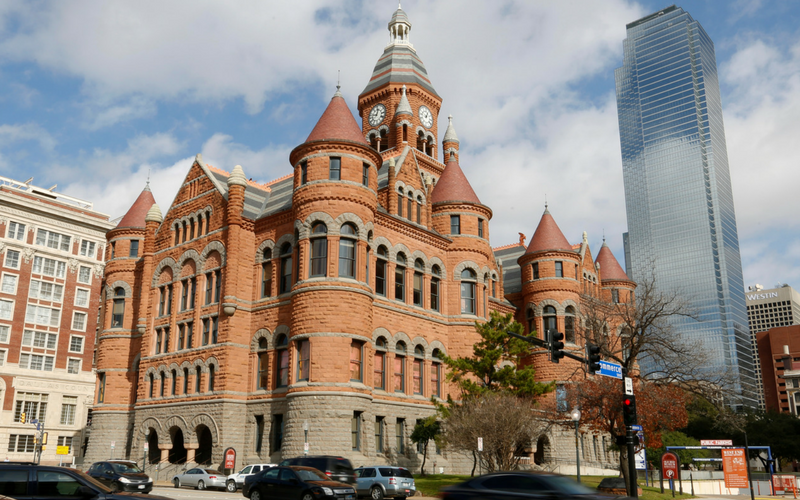Downtown Dallas is at once historic and futuristic. The mix of architectural styles on display from City Hall to the Arts District makes for a fascinating tour. While locations such as Dealey Plaza, the Majestic Theatre and the Davis Building serve as reminders of the city’s past, newer additions such as the Margaret Hunt Hill Bridge, Klyde Warren Park and the Omni reveal how Dallas’ trajectory continues to angle upward.
In some instances, renovation fuels innovation and an old building can become new again. Nowhere is this more in evidence than at the Dallas County Courthouse (100 S. Houston St.), now known as the Old Red Museum of Dallas County History & Culture.
Though no longer the seat of county government, “Old Red” stands as proof that Dallas has always thought big. Dallas County Commissioners authorized the courthouse’s construction in 1890, approving a staggering-for-the-era budget of a quarter of a million dollars. But the post-Civil War railroad boom had been kind to North Central Texas and pockets were flush. Construction got underway quickly and the building was complete by 1892.
The courthouse remains a superb example of Romanesque Revival (or Richardsonian Romanesque) style and its prominent, massive arches. Architect M. A. Orlopp specified that locally quarried materials constitute the bulk of the edifice’s construction, and so the hue of the courthouse’s sandstone exterior led to its eventual popular moniker. Over the years, however, some of the building’s other defining features have disappeared. For example, Old Red was originally crowned by a 96-foot tall clock tower. Unfortunately, it lacked internal bracing and would sway precariously in high winds. It was removed in 1919 in the interests of public safety.
Through the early decades of the 20th Century, renovations intended to bring the courthouse up-to-date further masked its genuine character. First, its original stone steps were covered with white terrazzo. Then, its ornately carved doors were replaced with plain wooden models. Later, its soaring ceilings were dropped and hung with fluorescent lighting. Even the Grand Staircase was removed in 1920 to make room for offices. Old Red was eventually all but abandoned in 1965 when the county government relocated to the more modern facilities housed at the George L. Allen, Sr. Courts Building (600 Commerce St.).
Thirty years passed before Dallas began serious discussions about the fate of this historic structure. In the 1990s, plans were announced to perform $23 million in restoration work and return Old Red to its former splendor. The Old Red Museum opened in 2007 and now welcomes both city residents and out-of-town visitors who are eager to learn more about Dallas’ uniquely Texan legacy.
Today, Old Red’s first floor houses a collection of 365 artifacts showcasing some connection to Dallas County. They range from the quirky — “Our Gang/Little Rascals” actor Spanky McFarland’s pants — to the dramatic, such as film footage shot moments after Bonnie and Clyde’s crime spree came to a violent end. Upstairs, museum-goers will find exhibits, an educational learning center, four mini-theaters and 41 touchscreen computers delivering interactive content. Further contributing to a sense of time and place is the fully restored Hatton W. Sumners Courtroom. This space features fixtures identical to those that filled Old Red’s six original courtrooms and paints the very picture of law and order with its elaborate judge’s bench, jury box and gallery seating.
Elsewhere, distinctive ornamental details communicate 19th Century Dallas’ sense of itself as a world-class metropolis. On the roof, for example, perch four decorative acroteria in the form of wyverns — mythical dragon-like creatures with two legs, spiny backs, barbed tails and wings. Two of these fearsome beasts are original. The other two were carefully reconstructed to match their brethren. And scattered throughout the building are some 100 vividly colored stained-glass windows called lunettes. Although the originals were removed in 1967, a few have since been recovered and reinstalled. The rest are being recreated by artisans as funding allows.
Also reconstructed is the courthouse’s Grand Staircase. Genuine salvaged remnants from the original four-story iron beauty sit alongside facsimile elements made from newer materials. The Grand Hall has also been restored to showcase its 20-foot ceilings, graceful arches, elegant chandeliers and traditional Victorian palette. One tour of the Grand Hall and it’s easy to see why Old Red has been added to the National Register of Historic Places. Given Old Red’s striking, unusual allure and its ideal location — across the street from the replica of Dallas founder John Neely Bryan’s cabin and The Sixth Floor Museum — it’s a natural choice for anyone looking to host a special event or celebration.
Join us on Facebook and Twitter to share tales of your own journey into the city’s past at the Old Red Museum, and to continue the conversation about the historic buildings that make Downtown Dallas a destination like no other.


